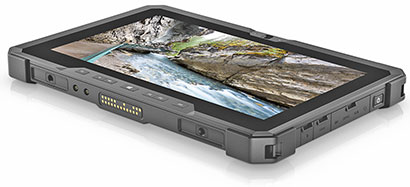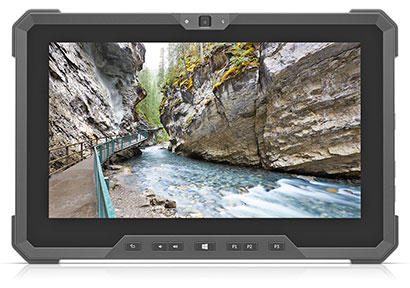|
Dell Latitude 7212 Rugged Extreme Tablet
With state-of-the-art tech, Dell's rugged tablet is now lighter, sharper, more secure, and much faster
(by Conrad H. Blickenstorfer)
Share on:




Talk about timing. A mere couple of weeks after we published our long term review of Dell's original Latitude 12 Rugged Tablet, Dell released its successor, the Latitude Rugged Extreme Tablet on August 29, 2017. And the new version addresses the few areas of the original rugged tablet where we were hoping for change or improvement. Here's how Dell made its already quite formidable rugged tablet even better.

First, there's speed. The original tablet was no slouch with its 4.5-watt Intel 5th generation Core-M processors, but the new tablet should be considerably more powerful with Intel 6th and 7th generation 15-watt full Core processors. Add to that up to twice the RAM and the availability of NVMe PCIe-based solid state disks, and these new tablets could be screaming fast.
Then there's weight. Dell made the original rugged tablet very solid and that meant even a stripped version weighed in at 3.5 pounds or so. The new one starts at just 2.8 pounds, a noticeable difference.
And a sharper screen. The display is now full HD 1920 x 1080 pixel instead of just 1366 x 768. Given all those super-sharp smartphones and consumer tablets, this was overdue and we're very happy. Full HD on a 11.6-inch screen means 190 pixels per inch, which is actually a tad sharper than Dell's 24-inch UltraSharp monitors.
And then there's a slew of tech updates, including faster WiFi and Bluetooth, the addition of a USB 3.1 Type-C port, and available 34Wh instead of 26Wh batteries. That means the new tablet can be equipped with 68Wh of battery power, good for up to 19 hours of operation.
The table below shows the major differences between Dell's original rugged tablet and the latest version:
|
Model
|
Rugged Tablet
|
Rugged Extreme Tablet
|
|
Launched
|
June 2015
|
August 2017
|
|
CPUs
|
5th gen Intel Core-M
|
6th and 7th gen Intel Core
|
|
Display
|
HD 1366 x 768 pixel
|
FHD 1920 x 1080 pixel
|
|
Weight
|
from 3.6 lbs.
|
from 2.8 lbs.
|
|
RAM
|
up to 8GB
|
up to 16GB
|
|
mSATA Mass storage
|
up to 500GB
|
up to 1TB
|
|
PCIe NVMe Mass storage
|
NA
|
up to 1TB
|
|
Power
|
2 x 26Wh
|
2 x 26Wh or 2 x 34Wh
|
|
Battery Life
|
Up to 12 hours
|
Up to 19 hours
|
|
USB
|
USB 3.0
|
USB 3.0 + USB 3.1 Type-C
|
|
Handle
|
Soft
|
Soft or hard
|
|
Kickstand
|
fixed angle
|
variable angle (180°)
|
There's one thing that we should make clear. When we learned that the new tablet was called "Rugged Extreme Tablet" instead of just "Rugged Tablet" like its predecessor, we thought that this referred to extra ruggedness. Just like there is the semi-rugged "Latitude 14 Rugged" laptop and also the fully rugged "Latitude 14 Rugged Extreme." That's actually not the case. We haven't had hands-on with the new tablet, but Dell says there is no substantial change in construction and ruggedness. This may lead to some customer confusion.
What hasn't changed
Dell prides itself in offering a rock-solid lineup of semi-rugged and fully rugged laptops, convertibles and tablets with both the kind of long life cycle customary in vertical, governmental and industrial markets, and also providing backward compatibility with accessories, peripherals and docking solutions for desktops and vehicles. As a result, the new tablet looks almost identical with the original version, with just the I/O port arrangements along the short sides of the tablets a bit different.

This means that the new Dell Latitude 12 Rugged Extreme Tablet remains a very attractive proposition for those who a) want an exceptionally well designed and executed tablet for tough jobs, b) want a pure tablet, but one with a perfectly matched optional detachable keyboard, and c) prefer one-stop shopping with a world-leading provider of commercial PCs with large scale production experience and extensive support.
What has changed are some small but important details. The optional kickstand which used to be fixed-angle can now be rotated a full 180 degrees. And there's now an optional hard carry handle. Both much appreciated.
Extensive connectivity, now with USB 3.1 Type-C
Flexible connectivity is crucial in many enterprise and field deployment, and it's an area where most consumer tablets are sorely lacking. Addressing that is not an easy task given the large number of possible connectivity requirements that may include legacy I/O such as serial or older card formats, especially while still living within the physical constraints of a compact and lightweight tablet.
In light of that, and looking forward, Dell added a USB 3.1 Type-C port to their new tablet. USB-C is the emerging standard for transferring data and much more. The connector is smaller and the same on both ends, and you don't have to check for orientation before plugging it in. And since USB-C supports a variety of interface protocols, adapters are available to add HDMI, VGA, DisplayPort, and other types of connectivity. USB Type-C version 3.1 supports transfer speeds up to 10 Gbps (twice as fast as UB 3.0 and 10 times as fast as USB 2.0) and potentially up to 100 watts of power.
As is, in addition to the USB Type-C port, the new Rugged Extreme Tablet comes with a standard USB 3.0 port, and audio in/out. Optionally available is a micro versions serial port. Micro HDMI is gone since it's supported via USB Type-C. There's still modular expansion via a pogo-pin connector on the back. Available are an extended I/O module that adds RJ45 Ethernet and two standard USB 3.0 ports, and a barcode and magnetic stripe reader module. Dell also provides a development kit for third-party developers or customers with unique module requirements.
A desk dock (see image in the sidebar to the right) provides not only charging for two spare batteries, but pretty much all the connectivity of a full function notebook. Also available is a compact vehicle dock that likewise adds full laptop I/O. New is an external battery charger for up to two extra batteries.
State-of-the-art wireless connectivity is crucial in a mobile computing device, be it in the office or out there on the road or in the field. Dell covers that with an Intel Dual Band Wireless-AC 8265 module with or without Bluetooth 4.2. Optional 4G LTE mobile broadband is available in versions for the North American and worldwide markets. A dedicated u-blox NEO-M8 positioning module is available also.
Full ruggedness
Ruggedness and durability are sore subjects with consumer tablets where almost universally style prevails over substance. Dell points out that the 5-year total cost of ownership of a rugged solution is actually only half that of a consumer product.
That doesn't mean a rugged device has to be a tank, just that it must be logically designed and built to handle whatever conditions and eventualities will be encountered in the real world. For the new Dell tablet, like the original one, that includes IP65 sealing, where the "6" means it's totally dustproof and the "5" means it's also protected against low pressure water jets from all directions. The device can operate within an extremely wide temperature range of -20° to 145° Fahrenheit (-29° to 63°Centigrade), which means practically anywhere.
Dell says the device is also independently tested according to MIL-STD-810G procedures for transit drop, blowing rain, blowing dust and sand, vibration, functional shock, freeze/thaw cycles, and more.

For use in hazardous locations, C1D2 (Groups A, B, C, and D) certification is available. These are becoming more and more important, and they are a prerequisite for deployment in industries such as oil, gas, and petrochemical manufacturing, and many others where ignitable gases or vapor may be present.
Security
For security, the Latitude 12 Rugged Extreme Tablet offers FIPS 140-2 TPM 2.0 functionality to store secured information. Some of the available processors support vPro, a set of Intel security and remote management technologies that offer multiple lines of built-in defenses, and there are also Dell's advanced security and data protection and encryption tools. There's a cable lock slot for physical security, available FIPS 201-certified smart card reader, contactless smart card reader, and fingerprint reader, and also NFC.
What Dell's newest rugged tablet means
Compared to the Dell's overall sales volume, the market for rugged tablets is fairly small, perhaps $600 million per year worldwide. However, within a relatively short time in the rugged tablet field Dell has already reached about 6% market share, a number the company seeks to double. With the updated tablet, Dell has a very realistic chance of reaching that goal.

The new model is much more powerful than the original and yet can last considerably longer between charges thanks to the new batteries. Its bright and much sharper display will be well received, as will be the addition of a USB 3.1 Type-C port, and the noticeably lighter weight. The new kickstand makes the tablet an even better 2-in-1 solution. And the availability of PCIe solid state disks shows that Dell is nimble on its feet in offering the latest high-performance technology.
Add to that Dell's massive corporate capabilities and services and one-stop shopping appeal, and it's easy to predict that this intelligently upgraded version of Dell's rugged tablet will likely be a very strong contender. — Conrad H. Blickenstorfer, August 2017
|



